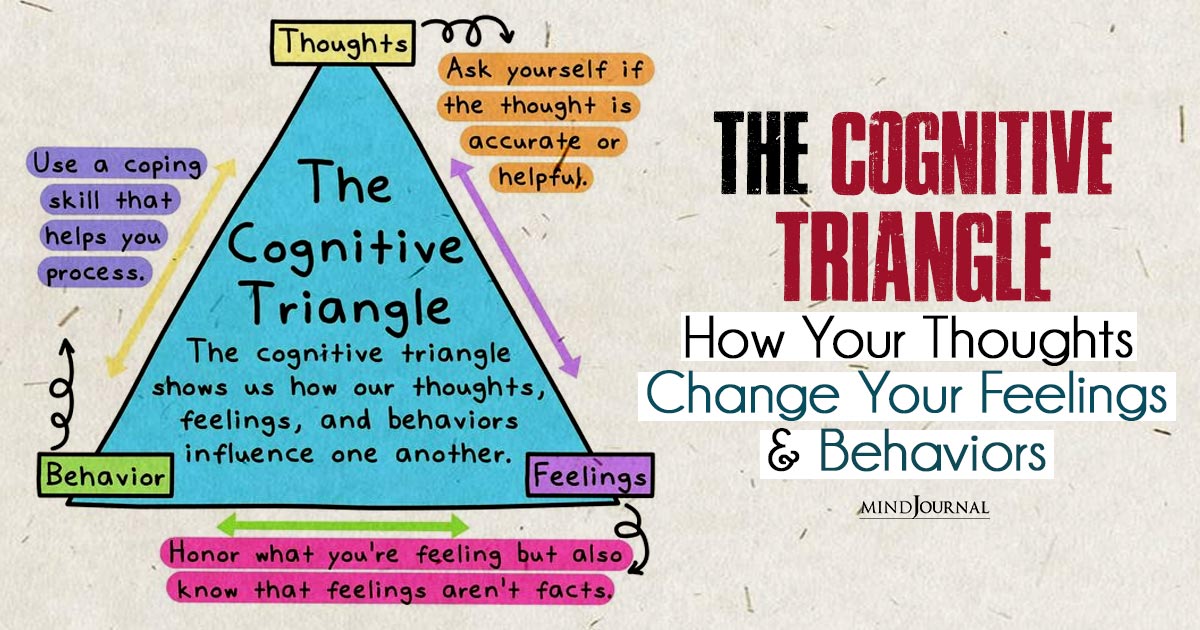Have you ever wondered why certain thoughts make you feel a particular way, which in turn influences your actions and behaviors? It’s fascinating how our minds work and how interconnected our thoughts, emotions, and behaviors truly are. Let’s explore the concept of the cognitive triangle.
The cognitive triangle is a powerful framework that sheds light on the intricate relationship between our thoughts, feelings, and behaviors. So let’s dive in.
What is the Cognitive Triangle?

The Cognitive Triangle is a simple way to understand how our thoughts, feelings, and behaviors are connected. This notion builds the base for cognitive behavior therapy (CBT). This psychological model highlights the interplay between these three elements.
It shows that our thoughts, emotions, and behaviors are deeply interconnected and influence each other in a continuous cycle. Our thoughts shape our emotions, which, in turn, impact our behaviors, ultimately reinforcing our thoughts.
So what is the cognitive triangle? Imagine a triangle with three corners: thoughts, emotions, and actions. Each corner influences the others. For example, if you think negatively about a situation, you might feel sad, leading to behaviors like withdrawing or avoiding. Alternatively, positive thoughts can lead to happier feelings and more productive actions.
Related: 15 Common Cognitive Distortions That Twist Your Thinking
Understanding this triangle helps us recognize patterns and how changing one corner can impact the others, empowering us to manage our emotions and behaviors more effectively.
Thoughts: The Architects of Our Reality
Our thoughts are the building blocks of our perceptions and experiences. They are the silent narrators in our minds, constantly interpreting and making meaning of the world around us.
These thoughts can be automatic and subconscious, arising spontaneously in response to external stimuli or internal triggers. They can be positive, negative, or neutral, and they have a profound effect on our emotions and actions.
Emotions: The Color Palette of Our Inner World
Emotions are the vivid colors that paint our experiences. They are our body’s response to our thoughts, providing us with valuable information about how we perceive and interpret the events in our lives.

Emotions can range from joy and excitement to sadness and fear, and they play a crucial role in guiding our behaviors. They can motivate us to take action or hold us back in a state of inaction.
Behaviors: The Outward Manifestation of Our Inner Landscape
Behaviors are the visible expressions of our thoughts and emotions. They are what others observe and how we interact with the world.
Our behaviors can be conscious or unconscious, intentional or automatic. They can reinforce our thoughts and emotions, creating a feedback loop that perpetuates our patterns of thinking and feeling.
Related: How Cognitive Distortions Harm Us
How Does the Cognitive Triangle Work?
The cognitive triangle operates in a continuous loop, with each element influencing and shaping the others. Let’s explore how this process unfolds:
1. Thoughts -> Emotions
Our thoughts have a direct impact on our emotions. For example, if we constantly dwell on negative thoughts, such as “I’m not good enough,” we are likely to experience feelings of self-doubt, sadness, or anxiety.
Conversely, positive thoughts like “I can handle this challenge” can generate feelings of confidence and optimism.
2. Emotions -> Behaviors
Our emotions can significantly influence our behaviors. For instance, if we feel angry or frustrated, we might express these emotions through aggressive or confrontational actions.

On the other hand, if we feel happy and content, we are more likely to engage in friendly and cooperative behaviors.
Our behaviors can reinforce and shape our thoughts. For instance, if we repeatedly avoid social situations due to anxiety, we may start to develop thoughts like “I’m socially awkward” or “People don’t like me.”
Our behaviors can perpetuate negative thinking patterns and limit our experiences.
Now that we know how does the cognitive triangle work, let’s figure how we can use it to better manage our thoughts, emotions and behaviors.
Breaking the Cycle: Cognitive Restructuring
The cognitive triangle offers us a powerful tool for personal growth and change. By understanding the interconnections between our thoughts, emotions, and behaviors, we can identify unhelpful patterns and actively reshape them. This process is known as cognitive restructuring.
Cognitive restructuring involves challenging and replacing negative or irrational thoughts with more realistic and positive ones. By doing so, we can transform our emotions and behaviors, leading to healthier and more fulfilling lives.
Techniques such as cognitive-behavioral therapy (CBT) can be effective in helping individuals restructure their cognitive patterns.
Cultivating Self-Awareness: The Key to Transformation
Developing self-awareness is essential in working with the cognitive triangle. By becoming aware of our thoughts, emotions, and behaviors, we gain insights into the underlying patterns that shape our experiences.
Mindfulness practices, journaling, and therapy can all help cultivate self-awareness and allow us to make conscious choices rather than being driven by automatic reactions.
Related: Understanding Depression With Beck’s Cognitive Triad
Takeaway

The cognitive triangle offers us a profound understanding of the intricate relationship between our thoughts, emotions, and behaviors. By recognizing the power of this interplay, we can take charge of our mental and emotional well-being.
By practicing cognitive restructuring and cultivating self-awareness, we can break free from negative cycles, shift our perspectives, and create positive change in our lives.
Remember, every thought is an opportunity to reshape your reality, one cognitive step at a time.
Frequently Asked Questions (FAQs):
How do you explain the cognitive triangle to a child?
The cognitive triangle shows how thoughts, feelings, and actions are connected, helping us understand and manage our emotions.
Why is it important to understand the cognitive triangle?
Understanding the cognitive triangle helps us manage feelings better and make positive choices in how we react.
Where did the cognitive triangle come from?
The cognitive triangle is a concept from cognitive-behavioral therapy, a type of therapy that helps people change negative patterns.










Leave a Reply